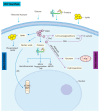Methylglyoxal in the Brain: From Glycolytic Metabolite to Signalling Molecule
- PMID: 36432007
- PMCID: PMC9696358
- DOI: 10.3390/molecules27227905
Methylglyoxal in the Brain: From Glycolytic Metabolite to Signalling Molecule
Abstract
Advances in molecular biology technology have piqued tremendous interest in glycometabolism and bioenergetics in homeostasis and neural development linked to ageing and age-related diseases. Methylglyoxal (MGO) is a by-product of glycolysis, and it can covalently modify proteins, nucleic acids, and lipids, leading to cell growth inhibition and, eventually, cell death. MGO can alter intracellular calcium homeostasis, which is a major cell-permeant precursor to advanced glycation end-products (AGEs). As side-products or signalling molecules, MGO is involved in several pathologies, including neurodevelopmental disorders, ageing, and neurodegenerative diseases. In this review, we demonstrate that MGO (the metabolic side-product of glycolysis), the GLO system, and their analogous relationship with behavioural phenotypes, epigenetics, ageing, pain, and CNS degeneration. Furthermore, we summarise several therapeutic approaches that target MGO and the glyoxalase (GLO) system in neurodegenerative diseases.
Keywords: behavioural phenotypes; bioenergetics; glyoxalase; homeostasis; methylglyoxal; neurodegenerative; side-product.
Conflict of interest statement
The authors declare that they have no competing interests.
Figures



Similar articles
-
The Role of Glyoxalase in Glycation and Carbonyl Stress Induced Metabolic Disorders.Curr Protein Pept Sci. 2020;21(9):846-859. doi: 10.2174/1389203721666200505101734. Curr Protein Pept Sci. 2020. PMID: 32368974 Review.
-
Methylglyoxal, a Highly Reactive Dicarbonyl Compound, in Diabetes, Its Vascular Complications, and Other Age-Related Diseases.Physiol Rev. 2020 Jan 1;100(1):407-461. doi: 10.1152/physrev.00001.2019. Epub 2019 Sep 20. Physiol Rev. 2020. PMID: 31539311 Review.
-
Dietary Quercetin Reduces Plasma and Tissue Methylglyoxal and Advanced Glycation End Products in Healthy Mice Treated with Methylglyoxal.J Nutr. 2021 Sep 4;151(9):2601-2609. doi: 10.1093/jn/nxab176. J Nutr. 2021. PMID: 34091674
-
The role of methylglyoxal and the glyoxalase system in diabetes and other age-related diseases.Clin Sci (Lond). 2015 Jun;128(12):839-61. doi: 10.1042/CS20140683. Clin Sci (Lond). 2015. PMID: 25818485 Review.
-
Nordihydroguaiaretic acid inhibits glyoxalase I, and causes the accumulation of methylglyoxal followed by cell-growth inhibition.Mol Biol Rep. 2022 Nov;49(11):10499-10507. doi: 10.1007/s11033-022-07929-6. Epub 2022 Sep 20. Mol Biol Rep. 2022. PMID: 36127524
Cited by
-
Impaired Detoxification of Trans, Trans-2,4-Decadienal, an Oxidation Product from Omega-6 Fatty Acids, Alters Insulin Signaling, Gluconeogenesis and Promotes Microvascular Disease.Adv Sci (Weinh). 2024 Jan;11(4):e2302325. doi: 10.1002/advs.202302325. Epub 2023 Dec 7. Adv Sci (Weinh). 2024. PMID: 38059818 Free PMC article.
-
African walnut (Plukenetia conophora) oil promotes glucose uptake while improving energy metabolism and steroidogenesis and maintaining surface architecture in rat testes.Front Nutr. 2024 Nov 19;11:1505453. doi: 10.3389/fnut.2024.1505453. eCollection 2024. Front Nutr. 2024. PMID: 39628465 Free PMC article.
-
Novel Approaches to the Establishment of Local Microenvironment from Resorbable Biomaterials in the Brain In Vitro Models.Int J Mol Sci. 2023 Sep 28;24(19):14709. doi: 10.3390/ijms241914709. Int J Mol Sci. 2023. PMID: 37834155 Free PMC article. Review.
-
Glucose Fluctuation Inhibits Nrf2 Signaling Pathway in Hippocampal Tissues and Exacerbates Cognitive Impairment in Streptozotocin-Induced Diabetic Rats.J Diabetes Res. 2024 Jan 19;2024:5584761. doi: 10.1155/2024/5584761. eCollection 2024. J Diabetes Res. 2024. PMID: 38282656 Free PMC article.
-
Glyoxalase System in Breast and Ovarian Cancers: Role of MEK/ERK/SMAD1 Pathway.Biomolecules. 2024 May 15;14(5):584. doi: 10.3390/biom14050584. Biomolecules. 2024. PMID: 38785990 Free PMC article. Review.
References
-
- Shin M.J., Kim D.W., Lee Y.P., Ahn E.H., Jo H.S., Kim D.S., Kwon O.S., Kang T.C., Cho Y.J., Park J., et al. Tat-glyoxalase protein inhibits against ischemic neuronal cell damage and ameliorates ischemic injury. Free Radic. Biol. Med. 2014;67:195–210. doi: 10.1016/j.freeradbiomed.2013.10.815. - DOI - PubMed
-
- Bilova T., Paudel G., Shilyaev N., Schmidt R., Brauch D., Tarakhovskaya E., Milrud S., Smolikova G., Tissier A., Vogt T., et al. Global proteomic analysis of advanced glycation end products in the Arabidopsis proteome provides evidence for age-related glycation Hotspots. J. Biol. Chem. 2017;22:15758–15776. doi: 10.1074/jbc.M117.794537. - DOI - PMC - PubMed
Publication types
MeSH terms
Substances
LinkOut - more resources
Full Text Sources
Research Materials

